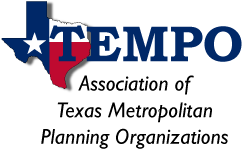Resources for MPOs
July 13th-14th TEMPO Meeting Content
DAY 1 AGENDA – Recording
Welcome – MPO Director Introductions – David Jones, Executive Director of TEMPO and MPO Director of Lubbock MPO (1:00-1:10pm)
TPP Division Updates (1:10-2:05pm)
1. Safety Task Force Update, Casey Wells, TxDOT (15 minutes) – Presentation
2. Update on Eagle Pass MPO Developments, Phillip Tindall, TxDOT (10 minutes)
3. 504.E Workforce Development Options, Audrey Zenon, TxDOT (15 minutes) – Presentation
4. Update on Census Urban Boundaries, Jeremy Rogers, TxDOT (15 minutes) – Presentation
FHWA Updates (2:05-2:55)
1. General Updates, Michael Leary, FHWA (15 minutes)
2. Presentation on Examples of Equity Analysis Tools for Transportation Planning, Kirk Fauver (15 minutes) – Presentation
3. Latest Updates on TMAs, Kirk Fauver (5 minutes)
4. USDOT, Office of Inspector General: Update on Waste, Fraud, and Abuse, Reginald Lee, Special Agent in Charge (15 minutes) – Presentation
TEMPO Subcommittees (3:10-3:15pm)
1. Status of the Letter of Support for the Resilience Working Group, David Jones (5 minutes)
Plans, Studies, Research, Conferences, etc, (3:15-5:10pm)
1. Key Collaborations – Health in Transportation, Victoria Martinez, FHWA’s Office of Air Quality (25 minutes) – Presentation
2. Presentation on Best Practices from Decision Lens, Marco Trigueros, Decision Lens (15 minutes) – Presentation
3. Status Report on the Vulnerable Road User Project, TBD, TxDOT (15 minutes)
4. Presentation on the Texas State Infrastructure Bank, Dallas Teston, TxDOT (15 minutes) – Presentation
5. Traffic Data Service Updates on Wejo, Replica, and INRIX Data Uses, Bethany Wyatt, TxDOT (15 minutes) – Presentation
6. Report Out from the Congestion Management Workshop, Genevieve Bales, FHWA (15 minutes)
7. Preview of the STIP Training, Lori Morel, TxDOT (15 minutes) – STIP Training Agenda
Concluding Remarks – TEMPO Executive Director David Jones (5:10-5:15pm)
DAY 2 AGENDA– Recording
Carbon Reduction Program, Adriana Torcat, TxDOT (8:30-9:00am) – Presentation
MPO 101 (9:00-11:00am)
1. General 101 and Introduction to MTP Developments with Updates on Latest BIL and Planning Emphasis Areas and Connections to Various MTP Sections, Bob Hazlett, TTI (90 minutes) – Presentation
2. Strategies to Solicit Optimal Engagement from Policy Board Members on MTP Development, Bob Hazlett, TTI (30 minutes) – Presentation
TEMPO Executive Board Meeting (11:00am-12pm)
March 23rd-24th TEMPO Meeting Content
DAY 1 AGENDA – Recording
- Welcome – MPO Director Introductions – David Jones, Executive Director of TEMPO and MPO Director of Lubbock MPO (1:00-1:10pm)
- TPP Division Updates
- Annual Project Listing – Phillip Tindall, TxDOT and Sandra Rodriguez, TTI, (1:10-1:25pm)- Presentation Link
- UPWP Considerations for Safety Task Force-Funded Action Plans – Phillip Tindall, TxDOT, (1:25-1:35pm)- Presentation Link
- Census Urban Area Classification – David Freidenfeld, TxDOT (1:35-2:05pm)- Presentation Link
- MPO Boundary Smoothing – Jeremy Rogers, TxDOT
- New MPOs and TMAs Updates/PL Funding Considerations – Phillip Tindall, TxDOT- No Presentation
- Statewide Planning Update, Adriana Torcat, TxDOT (2:05-2:35pm)- Presentation Link
- Carbon Reduction Program
- Statewide Resilience Plan
- Statewide Long-Range Plan
- Functional Classification Process Changes
- STIP Updates, Lori Morel, TxDOT (2:35-2:50pm)- Presentation Link
- FHWA Updates (2:50-3:20pm)
- Michael Leary, FHWA
- Report Out on Complete Streets Workshop – Kirk Fauver, FHWA
- Break (3:20-3:35pm)
- TEMPO Subcommittees
- STIP Subcommittee Updates, Lori Morel, TxDOT (3:35-3:45pm)
- Resilience Improvement Working Group – Jeff Neal, NCTCOG- Updates on Letter submittal- (3:45-3:55pm)- No Presentation
- Bylaw Committee Discussion and Consideration of Appropriate Action on Recommendations– Cameron Walker, MPO Director of Permian Basin MPO (3:55-4:25pm)- Approved Bylaws
DAY 2 AGENDA– Recording
- Plans, Studies, Research, Conferences, etc, (continued)
- Safety Task Force Updates – Dan Kessler/Natalie Bettger, NCTCOG (8:30-8:50am)- Presentation Link
- Performance Measures (8:50-9:45am)
- PM2: Pavement Condition – Jenny Li, TxDOT (7.5 minutes) – Presentation Link
- Bridge Condition – Bernie Carrasco, TxDOT and Jenny Li, TxDOT (15 minutes)- Presentation Link
- PM3: Congestion Performance – David Schrank, TTI (15 minutes)– Presentation Link
- What’s next for MPOs? – Jose Campos, FHWA (15 minutes)- No Presentation
- MPOs Adopting Targets
- Impacts of Potentially Missing Targets
- Incorporating PMs into TIPs – Phillip Tindall, TxDOT (10 minutes)- Presentation Link
- TxDOT Database of Non-Motorized Traffic Counts – Rob Benz, TTI (9:45-10:00am)- Presentation Link
- Legislative Session Impact Items Report- Terry Martinez, TxDOT Legislative Affairs Office (10:00-10:20am)- Presentation Link
- Electrification NEVI Plan Updates and Next Steps for Coordination – Michael Chamberlain, TxDOT- (10:20-10:50am)- No Presentation
- Summer Meeting Discussion and Location Selection – David Jones, Executive Director of TEMPO (10:50-11:10am)- No Presentation
- Break (11:10-11:25am)
- FHWA and TxDOT TPP 2023 Training Topics Discussion – Phillip Tindall (11:25-11:40am)- No Presentation
- Air Quality and Conformity – May 10-11Congestion Management Process (CMP) –June (tentative)STIP – June (tentative)
- Open Discussion on other Topics (e.g., MPO 101, PMDIS, etc.)
- Concluding Remarks – TEMPO Executive Director David Jones (11:40-11:45am)- No Presentation
Posted 03/30/2023
~~~~~~~~~~~~~~~~~~~~~~~~~~~~~~~~~~~~~~~~~~~~~~~~~~~~~~~~~~~~~~~~
Planning & Environmental Linkages Workshop
FHWA held a Planning & Environmental Linkages Workshop on December 9th, 2022 at the TxDOT Headquarters Campus in Austin, TX. The link above contains a zipfile with presentation, agenda, and scenario contents and materials.
Posted 12/13/2022
~~~~~~~~~~~~~~~~~~~~~~~~~~~~~~~~~~~~~~~~~~~~~~~~~~~~~~~~~~~~~~~~
December 8th TEMPO Meeting Content
AGENDA
- Welcome – MPO Director Introductions – David Jones (9:30-9:40am)- No Presentation
- AMPO Dues Updates
- TPP Division Updates (9:40-9:50am) Phillip Tindall,- No Presentation
- MPO AssignmentsAPER/APL Reports and Updates
- Organizational Updates
- Carbon Reduction
- FHWA updates (9:50-10:05am)- Michael Leary, FHWA- No Presentation
- Texas MPO Elections (10:05-10:15am)
- Three Non-TMA Candidate Votes
- Two TMA Candidate Votes
TMA 1 Results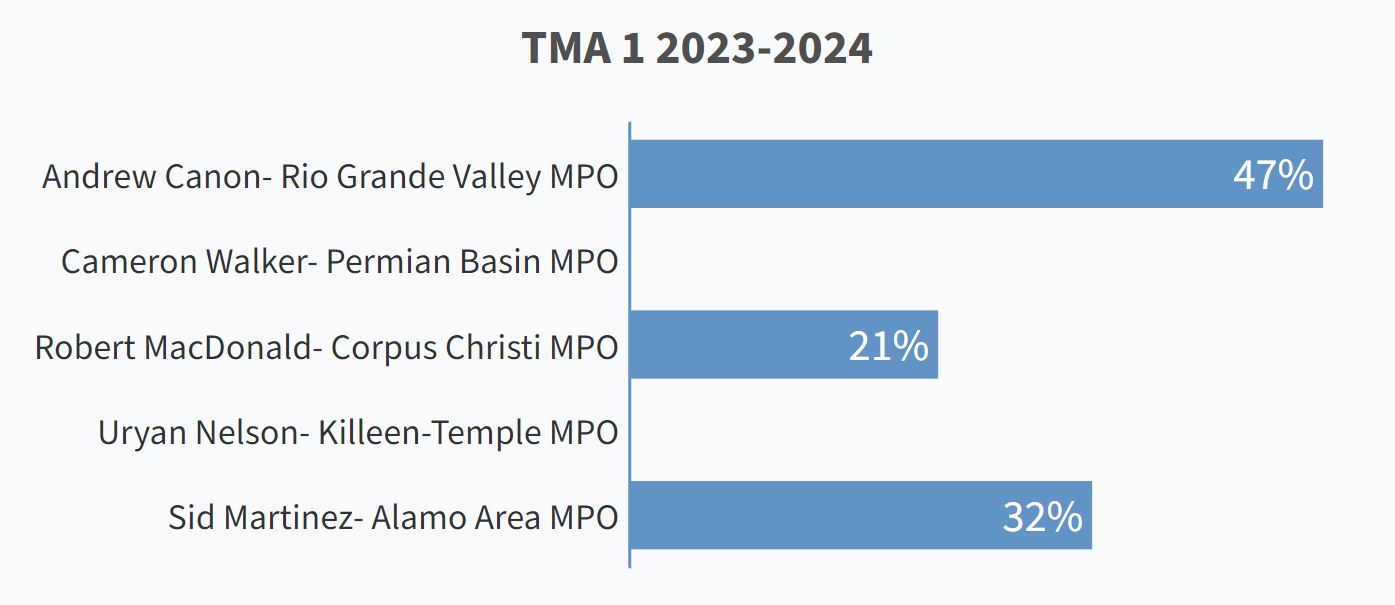
Non-TMA 1 Results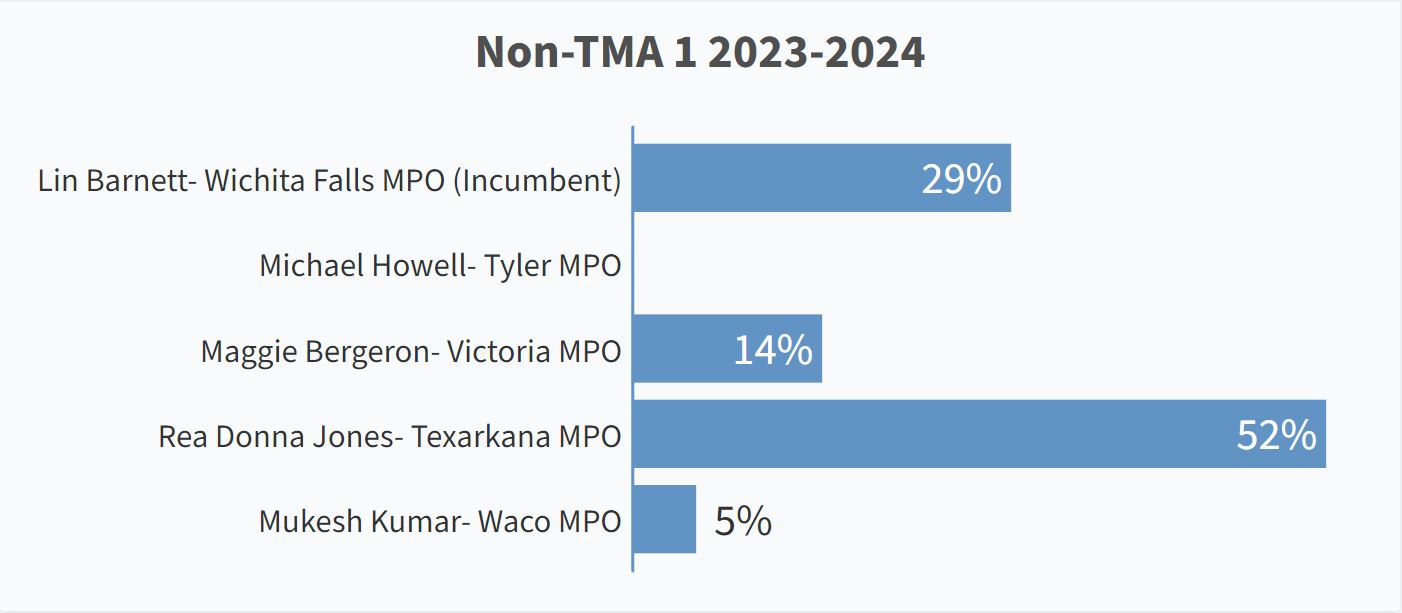
TMA 2 Results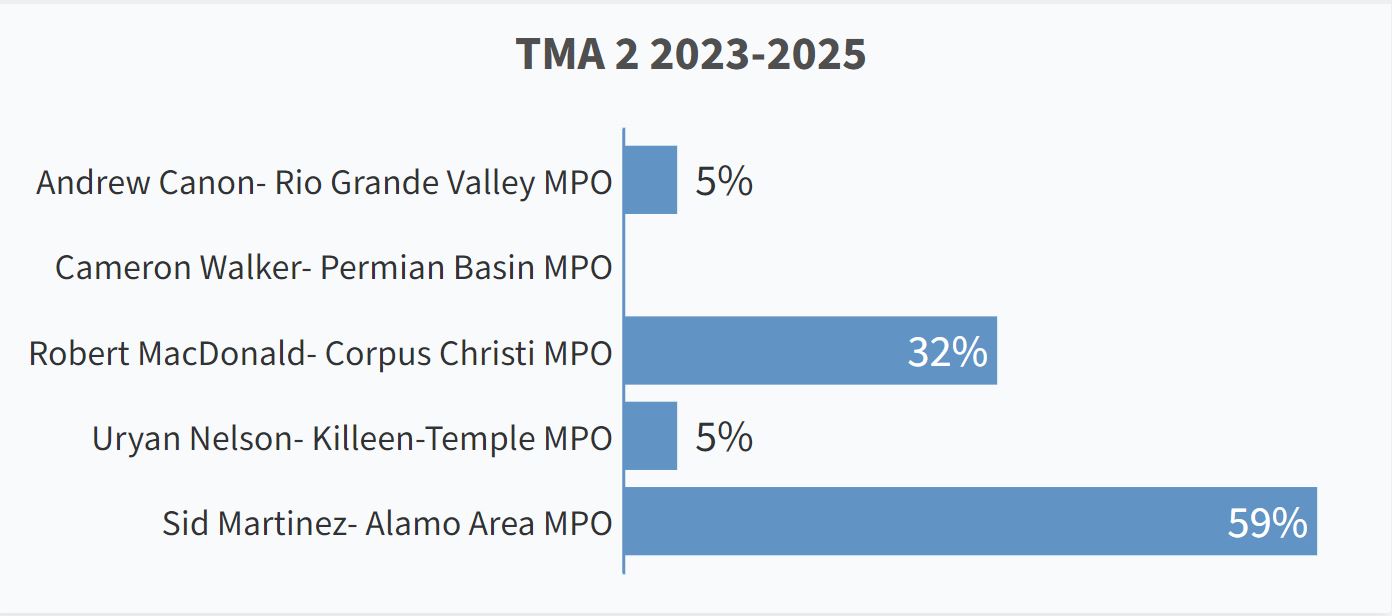
Non-TMA 2 Results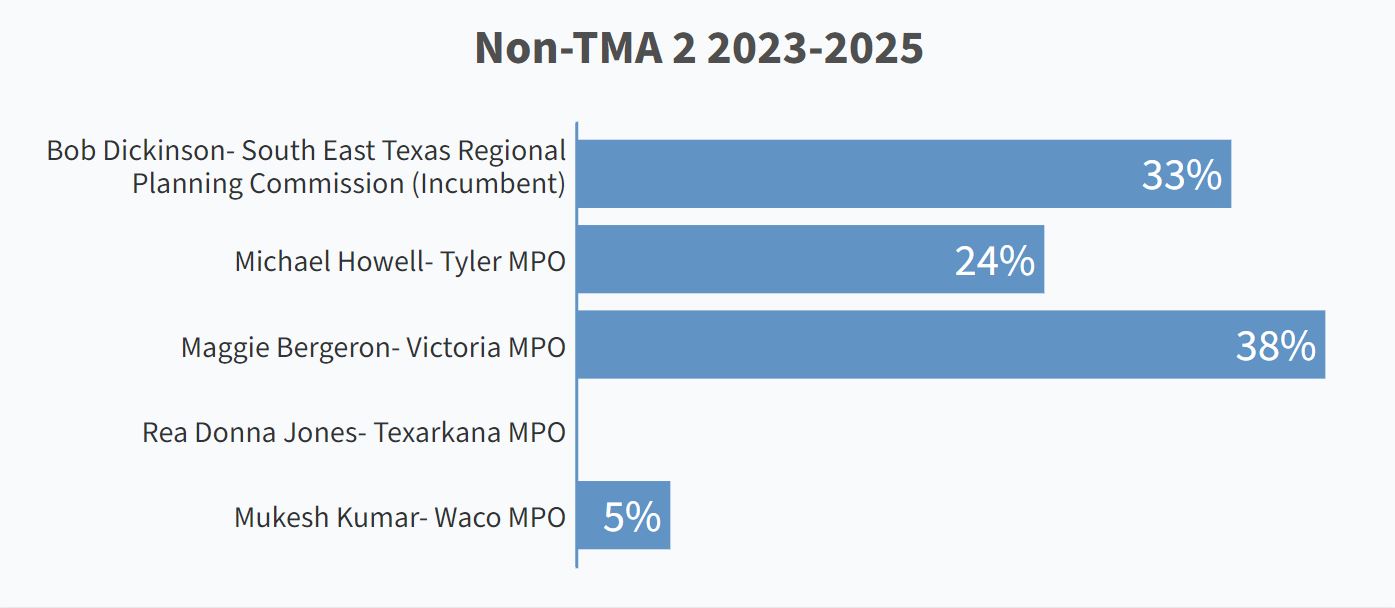
Non-TMA 3 Results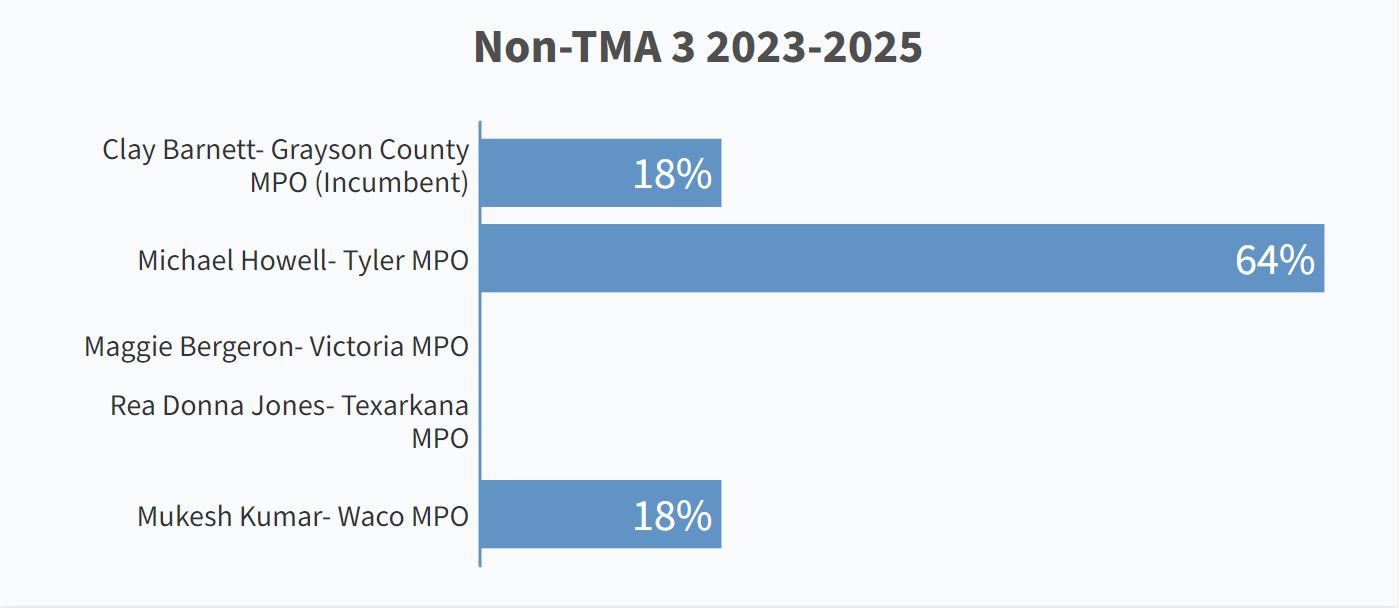
- TEMPO Subcommittees (10:15-10:50am)
- Resilience Improvement Working Group – Jeff Neal, NCTCOG
- For the Body to Consider Approving a Letter of Support Request to Continue the Resilience Working Group Activities
- Vote to continue the resilience working group
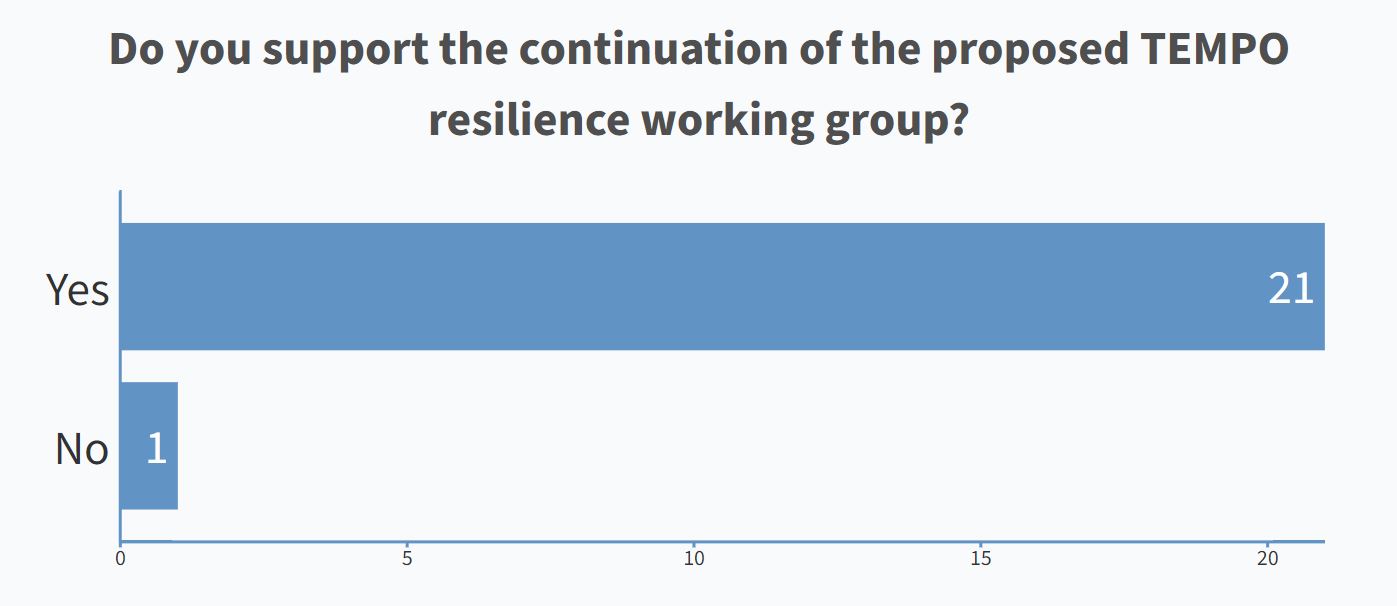
- Bylaw Update Committee – Cameron Walker, PBMPO
- STIP Subcommittee – Lori Morel, TxDOT
Plans, Studies, Research, Conferences, Etc.
- Systems Planning IAC Review – Bill Frawley and Jolanda Prozzi, TTI (10:50-11:10am)- Presentation Link
- Texas Freight Plan – Sherry Pifer (TPP) (11:10-11:40am)- Presentation Link
- Statewide Long-Range Transportation Plan (SLRTP) – Robert Ramirez (TPP) and Phillip Baker (AECOM) (11:40-12:10pm)- Presentation Link
- Resilience Improvement Working Group – Jeff Neal, NCTCOG
- Lunch (12:10pm-1:10pm)
- FHWA and TxDOT TPP 2023 Training Topics Discussion – Phillip Tindall (1:10-1:25pm) – No Presentation
- Air Quality
- CMP
- Open Discussion on other Topics (e.g., MPO 101, PMDIS, etc.)
- Plans, Studies, Research, Conferences, etc, (continued)
- Safety Task Force Updates- Natalie Bettger, NCTCOG (1:25-1:35pm) – Presentation Link
- Note: the slides from TxDOT were just screenshots and TxDOT plans to send an update to the group that will be from Michael Chacon or Tito Gonzalez as discussed during the meeting
- Performance Measures Update – Carlos Calle (TPP) (1:35-1:45pm)- No Presentation
- PM2: Pavement and Bridge Condition Updates
- Public Involvement Best Practices– Susan Howard (TPP) (1:45-2:05pm)- Presentation Link
- Texas Highway Safety Program Grants – Lydia Bryan Valdez (TxDOT Traffic Safety Division) (2:05-2:25pm)- Presentation Link
- Climate Vulnerability Index: A Tool for Transportation Planners, Grace Lewis, EDF (2:25-2:40pm) – Presentation Link
- Legislative Session Impact Items Report- Rebekah Gongora, NCTCOG (2:40-3:00pm) – Presentation Link
- Electrification NEVI Plan Updates and Next Steps for Coordination – Michael Chamberlain, TxDOT (3:00-3:10pm)- Presentation Link
- Safety Task Force Updates- Natalie Bettger, NCTCOG (1:25-1:35pm) – Presentation Link
- Break (3:10-3:25pm)
- Plans, Studies, Research, Conferences, etc, (continued)
- TxDOT Database of Non-Motorized Traffic Counts – Rob Benz and Shawn Turner (3:25-3:40pm)- No Presentation
- Meeting Summary Review – Carol Court (3:40-3:50pm)- No Presentation
- Completing our Streets, Barbara McCann FHWA (3:50-4:35pm)- Presentation Pending
- Planning and Engagement Linkages, Mack Frost, FHWA Presentation (4:35-5:35pm)- Presentation Link
- Concluding Remarks – TEMPO Executive Director David Jones (5:35-5:45pm)- No Presentation
- Executive Committee Meeting (5:45-6:45pm)
Posted 12/13/2022
~~~~~~~~~~~~~~~~~~~~~~~~~~~~~~~~~~~~~~~~~~~~~~~~~~~~~~~~~~~~~~
AASHTO Planning Advisory Service Level Memo: Equity-Oriented Performance Measures
in Transportation Planning
This PAS Memo examines the incorporation of equity considerations into the evaluation of transportation investments. Using this information, planners have an opportunity to modify future performance-based planning investment practices, particularly those of metropolitan planning organizations (MPOs), to increase the consideration of equity in project prioritization.
Posted 10/12/2022
~~~~~~~~~~~~~~~~~~~~~~~~~~~~~~~~~~~~~~~~~~~~~~~~~~~~~~~~~~~~~~~~
Texas Traffic Safety Program
These presentation slides depict the Texas Traffic Safety Program which uses National Highway Traffic Safety Administration (NHTSA) to award grants through the Texas Highway Safety Program.
Posted 10/12/2022
~~~~~~~~~~~~~~~~~~~~~~~~~~~~~~~~~~~~~~~~~~~~~~~~~~~~~~~~~~~~~~~~
New TxDOT Report: Virtual Public Involvement at Texas MPOs: Assessment of Activities during the COVID-19 Pandemic and Beyond
This document presents summaries of the research conducted to document VPI practices at Texas MPOs and offers commentary on strategies for continuous improvement to ensure that VPI is meeting the needs of all users of the transportation system.
Posted 9/27/2022
~~~~~~~~~~~~~~~~~~~~~~~~~~~~~~~~~~~~~~~~~~~~~~~~~~~~~~~~~~~~~~~~
Texas MPO UPWP Examples of 2.5% PL Set-Aside for Complete Streets
Some MPOs have asked for examples from other FY23 UPWPs and amendments of how this can be addressed under IIJA.
- Bryan-College Station MPO UPWP with Complete Streets Listed
- Lubbock MPO UPWP with Complete Streets Listed
Recently released information by the FHWA/FTA Transportation Planning Capacity Building (TPCB) initiative at:
https://www.planning.dot.gov/planning/topic_complete_streets.aspx
Posted 9/27/2022
~~~~~~~~~~~~~~~~~~~~~~~~~~~~~~~~~~~~~~~~~~~~~~~~~~~~~~~~~~~~~~~~
Pedestrian and Bicycle Funding Opportunities: 2022-09-09
This table indicates potential eligibility for pedestrian and bicycle activities and projects under U.S. Department of Transportation surface transportation funding programs. The table has links to program information. Project sponsors should integrate the safety, accessibility, equity, and convenience of walking and bicycling into surface transportation projects.
Posted 9/22/2022
~~~~~~~~~~~~~~~~~~~~~~~~~~~~~~~~~~~~~~~~~~~~~~~~~~~~~~~~~~~~~~~~
USDOT Memorandum: Eligibility of Title 23 and Title 49 Federal Funds for Commercial Motor Vehicle Parking
The purpose of this memorandum is to provide information on funding eligibility for commercial motor vehicle parking projects and to highlight the new requirements for commercial motor vehicle parking assessments as part of State Freight Plans to support safe and efficient movement of freight on the National Highway System and other major roads.
Posted 9/21/2022
~~~~~~~~~~~~~~~~~~~~~~~~~~~~~~~~~~~~~~~~~~~~~~~~~~~~~~~~~~~~~~
Webinar Briefings: Greenhouse Gas Emissions Performance Measure Notice of Proposed Rulemaking
The purpose of this message is to inform you of two external webinar briefings on the Greenhouse Gas Emissions Performance Measure Notice of Proposed Rulemaking. The briefings will be held via Zoom on:
- Tuesday, August 23rd from 3:00 p.m. to 4:00 p.m. Eastern. Register for the webinar here: https://usdot.zoomgov.com/webinar/register/WN_T8uvHycDS1WairAXVxoHBg
- Wednesday, August 24th from 11:00 a.m. to 12:00 p.m. Eastern. Register for the webinar here: https://usdot.zoomgov.com/webinar/register/WN_QhhX0V9EQZ6kWRmyNbOrqg
Join the Federal Highway Administration (FHWA) for a webinar on the Greenhouse Gas Emissions Performance Measure Notice of Proposed Rulemaking (NPRM). FHWA proposes to amend its regulations governing national performance management measures to establish a method for the measurement and reporting of greenhouse gas emissions associated with transportation under the Highways title of the United States Code, and to require State departments of transportation and metropolitan planning organizations to establish declining carbon dioxide (CO2) targets. During the webinars, staff from the Office of Natural Environment and Office of Infrastructure will give a presentation on the NPRM.
Please share with your State department of transportation and metropolitan planning organization stakeholders. Please contact John Davies at [email protected] if you have any questions.
Posted 8/17/2022
~~~~~~~~~~~~~~~~~~~~~~~~~~~~~~~~~~~~~~~~~~~~~~~~~~~~~~~~~~~~~~
July 12th TEMPO Meeting Content
- Agenda
- Update State of MPO Coordinator Assignments- Phillip Tindall
- FHWA’s Adjusted Urban Area Boundary Guidelines- Kirk Fauver
- Crowdsourcing for Operations “Instructor Course-In-a-Box”- Vaishali Shah, AEM Corporation, and Ralph Volpe, FHWA Office of Operations
- TEMPO Subcommittees- Bylaws Amendment Presentation- Cameron Walker
- Texas Electric Vehicle Plan – Ryan Granger
- Federal Performance Targets – Casey Wells/Phillip Tindall
- TxDOT Statewide Resilience Plan – Casey Wells
- Virtual Public Involvement Study – Tina Geiselbrecht
- TTI’s Congestion Management Process Assessment Web Tool (COMPAT); Update on Results of MPO Director Survey Regarding Future MPO Meetings, Frequency and Format; and Report Out on Census Transportation Planning Products Data Conference- Matt Miller
Posted 7/14/2022
~~~~~~~~~~~~~~~~~~~~~~~~~~~~~~~~~~~~~~~~~~~~~~~~~~~~~~~~~~~~~~
May 3rd TEMPO Meeting Content
Posted 5/3/2022
~~~~~~~~~~~~~~~~~~~~~~~~~~~~~~~~~~~~~~~~~~~~~~~~~~~~~~~~~~~~~~
April 13 TEMPO Meeting Content
- Agenda
- System Performance Measure (PM3) Texas Target Setting AND Texas PM3 Target Setting Spreadsheet– David Schrank, TTI
- Screening Tool for Equity Analysis of Projects (STEAP) Presentation– Supin Yoder, FHWA Office of Planning
- TxDOT/MPO Safety Task Force Update– Michael Morris, NCTCOG
- Census Bureau’s Proposed Urban Area Delineation Changes and Potential Applications– AND Evaluation of the Proposed 2020 Urban Area Criteria– Dr. Po-Chun Huang, University of Texas at San Antonio, Texas Demographic Center
- Bipartisan Infrastructure Law (BIL) Overview of Metropolitan Planning Provisions– Kirk Fauver, FHWA Texas Division
- Virtual Travel: Emerging Transportation Mode– Thomas Bamonte, NCTCOG
- The Future of TEMPO and Transportation Planning– Andrew Cannon, RGVMPO
- Urban Area Boundaries– Jeremy Rogers, TxDOT
- Meeting Recordings: Part 1 Part 2 Part 3
Posted 4/13/2022
~~~~~~~~~~~~~~~~~~~~~~~~~~~~~~~~~~~~~~~~~~~~~~~~~~~~~~~~~~~~~~
Embargoed: FHWA National Electric Vehicle Infrastructure (NEVI) Program News
Posted at the request of Kirk Fauver, FHWA:
2.10.2022 Request for Nominations Alternative Fuel Corridors 2022 Round 6
NEVI Formula Program Guidance 2-10-22
FHWA Notice – FY 2022 – N4510.863 – IIJA HIP NEVI Formula Program
Posted 2/10/2022
~~~~~~~~~~~~~~~~~~~~~~~~~~~~~~~~~~~~~~~~~~~~~~~~~~~~~~~~~~~~~~
Complete Bipartisan Infrastructure Law Overview of Highway Provisions,
Kirk Fauver, FHWA Texas Division Presentation
Posted 1/21/2022
~~~~~~~~~~~~~~~~~~~~~~~~~~~~~~~~~~~~~~~~~~~~~~~~~~~~~~~~~~~~~~
TEMPO October 16, 2021 Meeting- Recording
Posted 11/18/2021
~~~~~~~~~~~~~~~~~~~~~~~~~~~~~~~~~~~~~~~~~~~~~~~~~~~~~~~~~~~~~~
Infrastructure Investment and Jobs Act (IIJA)
Posted 11/17/2021
~~~~~~~~~~~~~~~~~~~~~~~~~~~~~~~~~~~~~~~~~~~~~~~~~~~~~~~~~~~~~~
2020 Census timelines and schedules for your use and information.
It is also publicly available at the following FHWA HQ’s website at: https://www.fhwa.dot.gov/planning/census_issues/urbanized_areas_and_mpo_tma/schedule/
Posted 9/13/2021
~~~~~~~~~~~~~~~~~~~~~~~~~~~~~~~~~~~~~~~~~~~~~~~~~~~~~~~~~~~~~~
“Coming Together for Equity” website
The U.S. Department of Transportation released a “Coming Together for Equity” website that provides information on transportation equity resources, Federal regulations, and considerations for incorporating nondiscrimination and environmental justice into transportation planning. These resources are intended to support State departments of transportation and metropolitan planning organizations as the agencies responsible for coordinating the transportation planning process.
Posted 9/10/2021
~~~~~~~~~~~~~~~~~~~~~~~~~~~~~~~~~~~~~~~~~~~~~~~~~~~~~~~~~~~~~~
Pedestrian and Bicycle Funding Opportunities
U.S. Department of Transportation Transit, Highway, and Safety Funds
Updated January 21, 2021
This table indicates potential eligibility for pedestrian and bicycle projects under U.S. Department of Transportation surface transportation funding programs. Additional restrictions may apply. See notes and basic program requirements below, and see program guidance for detailed requirements. Project sponsors should fully integrate nonmotorized accommodation into surface transportation projects. Section 1404 of the Fixing America’s Surface Transportation (FAST) Act modified 23 U.S.C. 109 to require federally-funded projects on the National Highway System to consider access for other modes of transportation, and provides greater design flexibility to do so.
Posted 9/2/2021
~~~~~~~~~~~~~~~~~~~~~~~~~~~~~~~~~~~~~~~~~~~~~~~~~~~~~~~~~~~~~~
Presentation on New Interstate Designations by FHWA and AASHTO
A recent PowerPoint presentation Kirk Fauver (FHWA) created and presented on August 6th for TEX-21 on the subject of new Interstate Designations by FHWA and AASHTO.
Posted 8/11/2021
~~~~~~~~~~~~~~~~~~~~~~~~~~~~~~~~~~~~~~~~~~~~~~~~~~~~~~~~~~~~~~
Recent TRB Resiliency Products
- Mainstreaming System Resilience Concepts into Transportation Agencies: A Guide (2021)
- May 6, 2021 TRB Webinar Slides: Senior Leadership’s Role in Embedding Transportation Resilience.
Posted 5/18/2021
~~~~~~~~~~~~~~~~~~~~~~~~~~~~~~~~~~~~~~~~~~~~~~~~~~~~~~~~~~~~~~
April 27, 2021
Meeting of the State of Texas Resilience Working Group
Presentations
- Matt Miller, Texas A&M Transportation Institute: Review of Texas MPOs Resiliency Survey and Poll Everywhere Results
- Jolanda Prozzi and Andrew Birt, Texas A&M Transportation Institute: Data and Tools to Assist in Developing Metropolitan Planning (MPO) Resiliency Plans
Meeting Recording
Posted 5/4/2021
~~~~~~~~~~~~~~~~~~~~~~~~~~~~~~~~~~~~~~~~~~~~~~~~~~~~~~~~~~~~~~
Environmental Justice and Title VI Resources Courtesy of Megan Dere, FHWA
Posted 4/27/2021
~~~~~~~~~~~~~~~~~~~~~~~~~~~~~~~~~~~~~~~~~~~~~~~~~~~~~~~~~~~~~~
FHWA/TxDOT Civil Rights Program Training – Fundamentals of Title VI for Subrecipients 04/13/2021
Posted 4/13/2021
~~~~~~~~~~~~~~~~~~~~~~~~~~~~~~~~~~~~~~~~~~~~~~~~~~~~~~~~~~~~~~
March 31, 2021
Meeting of the State of Texas Resilience Working Group
Presentations
- Uryan Nelson, Killeen-Temple MPO: The Regional Vulnerability & Resilience Framework
- Kathryn Vo, Houston-Galveston Area Council: Resiliency Pilot & Planning
- Dr. Ali Mostafavidarani, Project 0-7079: Establish TxDOT Transportation Resilience Planning Scorecard and Best Practices Project Review
Meeting Recording
Poll Everywhere Live Survey Links (for those MPOs who weren’t able to access the chat box during the meeting)
- Is your MPO Interested in development of a resiliency plan to protect vulnerable structures and transportation systems?
https://PollEv.com/multiple_choice_polls/S9UKXsz8MrjozHvUZonsy/respond
- From the results of the resiliency survey, what are your top three concerns or issues for your MPO region?
https://PollEv.com/free_text_polls/kgOcRhbNkNx378ufVnUIu/respond
- Would it be helpful to have a central repository of resiliency tools, data, techniques, best practices, roles and responsibilities, etc., on a Sharepoint or website?
https://PollEv.com/multiple_choice_polls/GroPQBDxQ7tJFlRYMwDXZ/respond
- Would you be interested in dividing up into regions with similar climate and geographical features (e.g., coastal, Central, South, Northwest (Panhandle), and Western regions)?
https://PollEv.com/multiple_choice_polls/xAGrUkcjcorX5JuZqtUDq/respond
- In general, for questions ranked 3 or lower please select the below options explaining the reasoning behind your ranking, or choose other if unsure. (Please provide clarifications in chat)
https://PollEv.com/multiple_choice_polls/djv6FaZHAQdOIWKYLPgiS/respond
- In general, for questions ranked 4 or above, please select the below options explaining the reasoning behind your ranking, or choose other if unsure. (Please provide clarifications in chat).
https://PollEv.com/multiple_choice_polls/9cbVG0jISET49iPQI61Mm/respond
- Click on the below question to indicate whether you have finished it or click on cells to the right if it is slated for short (<2 years), (2-4 years) medium, or long term (>4 years).
https://PollEv.com/clickable_images/hNAfv33sITPSSAWAmoMag/respond
- What would you suggest to further improve future Statewide Resiliency Working Group meetings?
https://PollEv.com/free_text_polls/eMl4cNtb2opk3RyiVwKnM/respond
Posted 3/31/2021
~~~~~~~~~~~~~~~~~~~~~~~~~~~~~~~~~~~~~~~~~~~~~~~~~~~~~~~~~~~~~~
Help the trails community demonstrate its ability to put America back to work and deliver the benefits of trails to all communities.
American Trails and our partners need your input to demonstrate the immense impact that trails and trail projects can have on workforce development and the economic recovery following the COVID-19 pandemic. As Congress, states, philanthropists, and others invest in economic stimulus and infrastructure projects, it is important that trails are included. This is why we need you.
American Trails, in collaboration with our partners in the trails community, is working to quantify the amount, diversity, and location of “shovel-ready” trail projects across the country. We need this information to quantify the capacity of the trails community to build, maintain, and develop trails now, and to provide input to the Departments of Agriculture and Interior process for prioritizing and awarding Great American Outdoors Act (GAOA) and Land and Water Conservation Fund (LWCF) funding.
Please submit your shovel-ready trail projects that, if funding were available and working conditions are safe, could be begun by this spring/summer and completed by the end of the 2025 Federal FY. This information will also help us to effectively advocate for inclusion of trails in the Federal economic response to COVID-19. The information you provide will help to mobilize trail projects, put trail workers on the ground, and sustain rural and urban economies through transportation and recreation infrastructure investments.
or, Download the PDF of the survey
Who should complete the survey?
Managers, either professional or volunteer, of “shovel-ready” trail projects. “Shovel-ready” trail projects are projects that, if funding is available and working conditions are safe, could be providing jobs by the summer of 2021. A project can be “shovel-ready” in any phase of development (e.g., planning, design, construction, maintenance), as long as jobs would be created by summer 2021 if the project were funded now. Prior to completing the survey, it may be helpful to take a moment now and gather the information you will need to respond to the following questions about your “shovel-ready” trail projects. This information includes:
- Project names and locations
- Approximate total project budgets and timelines
- Approximate numbers of project jobs or workers
- Project characteristics and features (e.g., land type, mileage, types of project work, user types, accessibility, etc.)
- If helpful, download this PDF of the survey questions so you can gather all information prior to filling out the online survey.
Working with American Trails, you may choose to keep detailed project information like budgets confidential, in which case your responses will only be made public in aggregated form (e.g., state, congressional district, agency level reporting). You may also choose to make your project details public, in which case, your project(s) will be reviewed by a group of trail community representatives from a diverse spectrum of trail user types and a prioritized list will be provided directly to Agency leadership for purposes of recommending GAOA and LWCF funding in the next fiscal year.
If you are a trail project manager of one or more “shovel-ready” projects, we strongly encourage you to provide information on your project(s). Without it, we will not be able to demonstrate the full power of trails to put people back to work and help America recover from the COVID-19 pandemic.
If you have any questions about the survey or American Trails’ efforts to advocate on behalf of the trails community, please email me.
Sincerely, Mike Passo, Executive Director
Thank you for supporting the trails community!
[email protected]
www.americantrails.org
Posted 3/3/2021
~~~~~~~~~~~~~~~~~~~~~~~~~~~~~~~~~~~~~~~~~~~~~~~~~~~~~~~~~~~~~~
Alternative Fuel Corridor Meeting Slide Presentations and followup info
I-35 AFC Signage Coalition_FHWA Slidedeck_11.18.2020
Clean Cities Overview & Goal of I-35 AFC Signage Coalition
We will hold our next meeting in early spring 2021 so stay tuned for additional information.
As a reminder, Round 5 is open for Alternative Fuels Corridor Nominations. The deadline to submit nominations is COB Wednesday, February 24, 2021. On Wednesday, December 9 the FHWA and DOT’s Volpe Center is hosting a webinar on the request for nominations. You won’t want to miss it – register here.
Emily Wolfe | Program Specialist | [email protected]
Metropolitan Energy Center | 816-531-7283/office | 913-548-8692/mobile | www.metroenergy.org
Posted 1/4/2021
~~~~~~~~~~~~~~~~~~~~~~~~~~~~~~~~~~~~~~~~~~~~~~~~~~~~~~~~~~~~~~
December 10th, 2020
Inaugural Meeting of the State of Texas Resilience Working Group
Presentations
- Becky Lupes, FHWA: Integrating Natural-Hazard Resilience into Transportation Planning
- Jolanda Prozzi, TTI: Overview of Completed TTI/TxDOT Resiliency Workshops
Relevant Documents
Posted 12/10/2020
~~~~~~~~~~~~~~~~~~~~~~~~~~~~~~~~~~~~~~~~~~~~~~~~~~~~~~~~~~~~~~
MAP-21/FAST ACT Pavement Performance Measures Presentation updated with FY 2020 data
Posted 12/2/2020
~~~~~~~~~~~~~~~~~~~~~~~~~~~~~~~~~~~~~~~~~~~~~~~~~~~~~~~~~~~~~~
Laredo MPO Value Capture Training (Impact Fees, Transportation Utility Fees, TRZs)
Street Impact Fees in Austin, Texas:
Street Maintenance Fees in Corpus Christi, Texas:
Transportation Reinvestment Zones (TRZs) in Horizon City, Texas:
Posted 12/1/2020
~~~~~~~~~~~~~~~~~~~~~~~~~~~~~~~~~~~~~~~~~~~~~~~~~~~~~~~~~~~~~~
The Federal Highway Administration (FHWA) is sharing these example practices of State DOT and MPO implementation of performance-based planning and programming (PBPP) to help advance the state of the practice.
This report shares how State Departments of Transportation (DOTs) and Metropolitan Planning Organizations (MPOs) are using their long-range statewide transportation plans, metropolitan transportation plans, statewide transportation improvement programs, and transportation improvement programs to: integrate performance-based plans and processes; evaluate past condition and performance; document performance measures and targets; report progress toward target achievement; link investment priorities to targets; and describe anticipated future target achievement.
Posted 11/23/2020
~~~~~~~~~~~~~~~~~~~~~~~~~~~~~~~~~~~~~~~~~~~~~~~~~~~~~~~~~~~~~~
Transportation Performance Management
State Biennial Performance Report for Performance Period 2018-2021
2020 MID PERFORMANCE PERIOD (MPP) PROGRESS REPORT
Posted 11/19/2020
~~~~~~~~~~~~~~~~~~~~~~~~~~~~~~~~~~~~~~~~~~~~~~~~~~~~~~~~~~~~~~
A good example of how to document performance targets in the transportation planning process as part of the FY 21-24 TIP developed by the San Antonio MPO (Jeanne Geiger):
FAST ACT Req Performance Measure Analysis of selected 21 24 TIP Projects
Posted 11/13/2020
~~~~~~~~~~~~~~~~~~~~~~~~~~~~~~~~~~~~~~~~~~~~~~~~~~~~~~~~~~~~~~
Texas Bridge Dashboard
The intent of this workbook is to provide MPOs with Texas’ bridge inventory data and a tool for interpreting historical data to establish bridge performance targets pursuant to federal requirements under 23 USC 490.
Posted 11/11/2020
~~~~~~~~~~~~~~~~~~~~~~~~~~~~~~~~~~~~~~~~~~~~~~~~~~~~~~~~~~~~~~
FHWA – InfoBridge
Posted 11/11/2020
~~~~~~~~~~~~~~~~~~~~~~~~~~~~~~~~~~~~~~~~~~~~~~~~~~~~~~~~~~~~~~
FTA’s MPO FAQ sheet on Public Transit Agency Safety Plans (PTASP) today
You may also access the interactive PDF document on the FTA website HERE.
Posted 11/6/2020
~~~~~~~~~~~~~~~~~~~~~~~~~~~~~~~~~~~~~~~~~~~~~~~~~~~~~~~~~~~~~~
FHWA HEPGIS Website
- Public website created by Office of Planning, Environment and Realty (HEP)
- Over 300 interactive GIS thematic maps and origin-destination commodity flow maps
- Accessed by users from all states and more than 50 countries
- Over 11 million annual webpage hits with 35,000 unique visitors
Posted 11/6/2020
~~~~~~~~~~~~~~~~~~~~~~~~~~~~~~~~~~~~~~~~~~~~~~~~~~~~~~~~~~~~~~
Example from SEMCOG on Resilience and Vulnerability Planning
https://semcog.org/plans-for-the-region/environment/climate-resilience
Posted 11/6/2020
~~~~~~~~~~~~~~~~~~~~~~~~~~~~~~~~~~~~~~~~~~~~~~~~~~~~~~~~~~~~~~
TTI’s Congestion Management Process Assessment Tool (COMPAT):
- COMPAT Website/Webtool:
https://compat.tti.tamu.edu
The purpose of Congestion Management Process Assessment Tool (COMPAT) is to assist Metropolitan Planning Organizations (MPOs) and stakeholders with congestion management process planning, performance-based planning and programming, and corridor study development. COMPAT uses annual averages for all Wednesdays and Saturdays from an INRIX XD speed data set procured by TxDOT to compute the Texas 100 Most Congested Road Sections report. The shapefiles from this INRIX XD speed data are layered, or conflated over the shapefiles for volume-based and TxDOT-maintained Roadway-Highway Inventory Network (RHiNO) data sets. COMPAT visualizes performance measures by drawing upon associated Texas 100 Most Congested Road Section Report
volume and speed data.
Posted 10/9/2020
~~~~~~~~~~~~~~~~~~~~~~~~~~~~~~~~~~~~~~~~~~~~~~~~~~~~~~~~~~~~~~
New Bike/Ped Data from TxDOT and TTI:
- Texas Bicycle and Pedestrian Count Exchange (BP|CX), a statewide database: https://mobility.tamu.edu/bikepeddata/
- Bicycle & Pedestrian Count Resources: https://www.txdot.gov/inside-txdot/modes-of-travel/bicycle/bicycle-pedestrian-count/bicycle-pedestrian-count-resources.html
Posted 8/24/2020
~~~~~~~~~~~~~~~~~~~~~~~~~~~~~~~~~~~~~~~~~~~~~~~~~~~~~~~~~~~~~~
Texas A&M Transportation Institute (TTI) Service Request Process July 2020
Posted 8/4/2020
~~~~~~~~~~~~~~~~~~~~~~~~~~~~~~~~~~~~~~~~~~~~~~~~~~~~~~~~~~~~~~
New TRB EJ and Equity Resources
TCRP report on Equity 25860
Recently published TCRP Report on equity analysis in regional transportation planning (link provided below). TRB has now consolidated many of its EJ and equity resources, see second link . . .
TCRP Report 214: Equity Analysis in Regional Transportation Planning Processes, Volume 1:
https://www.nap.edu/catalog/25860/equity-analysis-in-regional-transportation-planning-processes-volume-1-guide
Additional TRB EJ and Equity Resources:
https://www.nationalacademies.org/trb/blog/building-socioeconomic-equity-through-transportation-research
Posted 7/22/2020
~~~~~~~~~~~~~~~~~~~~~~~~~~~~~~~~~~~~~~~~~~~~~~~~~~~~~~~~~~~~~~
Now Available: TPM Essentials Video Series and Five New Web-based Training Courses
The Federal Highway Administration (FHWA) has posted the TPM Essentials video series on its website. Transportation Performance Management (TPM) is a strategic approach that uses system information to make investment and policy decisions to achieve national performance goals. Each TPM Essentials video condenses the complex TPM federal regulations and requirements into easy-to-understand concepts.
The TPM Essentials videos are between 5 and 12 minutes long. The website includes a downloadable companion document for each video, providing summary information and additional resources.
FHWA has also posted five new web-based training courses, which are available free of charge:
- NHI 138021 – Data for TPM
- NHI 138022 – Making the Connection between HPMS Data Items and TPM
- NHI 138023 – Communicating and Reporting on TPM
- NHI 138024 – Monitoring and Adjustment for TPM
- NHI 138025 – Investment Decision Making and TPM
Posted 1/29/2020
~~~~~~~~~~~~~~~~~~~~~~~~~~~~~~~~~~~~~~~~~~~~~~~~~~~~~~~~~~~~~~
FHWA Turner-Fairbank Highway Research Center Publishes Evaluation of Pedestrian Countdown Signals
FYI. The FHWA Turner-Fairbank Highway Research Center published a report that examines the effectiveness of pedestrian countdown signals. The research team collected traffic and crash data at a number of signalized intersections across the country and found that the presence of pedestrian countdown signals helped to reduce crash rates. The results of this research will help to promote similar strategies for nationwide implementation to improve pedestrian safety.
Posted 1/29/2020
~~~~~~~~~~~~~~~~~~~~~~~~~~~~~~~~~~~~~~~~~~~~~~~~~~~~~~~~~~~~~~
Planning for Infrastructure Resilience
Offers planners guidance in helping their communities consider new climate and flood realities in the comprehensive and capital improvements planning processes.
Across the country, communities are facing higher risks of flooding and cascading impacts from more frequent and intense storm events and sea level rise caused by climate change. Extreme weather will strain aging facilities and systems, and new projects will be at risk if they are not planned, designed, and constructed to account for climate-related stresses well into the future.
The report offers planners a road map, starting with preparation and planning. It introduces data and tools to help understand the risks of future flooding. Explore the vulnerability assessment process and get guidance in integrating that information into plans and policies. Then comes implementation, with chapters exploring how capital improvement plans, local regulations, and funding sources can help ensure that public infrastructure is resilient to flood and climate impacts for decades to come.
Posted 1/29/2020
~~~~~~~~~~~~~~~~~~~~~~~~~~~~~~~~~~~~~~~~~~~~~~~~~~~~~~~~~~~~~~
On January 13, Secretary of Transportation Elaine L. Chao announced the release of: “AV 4.0 – Ensuring American Leadership in Automated Vehicle Technologies.”
This is a joint initiative with the White House. Click the link to read more about Preparing for the Future with AV 4.0.
Posted 1/29/2020
~~~~~~~~~~~~~~~~~~~~~~~~~~~~~~~~~~~~~~~~~~~~~~~~~~~~~~~~~~~~~~
Compendium of interviews regarding PEL implementation
A report documenting examples of Planning and Environment Linkages (PEL) approaches in state DOTs
Posted by the Federal Highway Administration. THE REPORT is a compendium of interviews regarding PEL implementation. The DOTs provided insights and lessons learned that informed the development of the FHWA’s new PEL Guidebook (forthcoming from HQ’s). The report provides highlights and key takeaways from FHWA’s discussions with DOTs.
Posted 1/29/2020
~~~~~~~~~~~~~~~~~~~~~~~~~~~~~~~~~~~~~~~~~~~~~~~~~~~~~~~~~~~~~~
The BTS Pocket Guide to Transportation
A popular, quick reference guide that provides transportation statistics at your fingertips. It provides key information and highlights major trends on the U.S. transportation system. The Pocket Guide is available in both a web and mobile app. It includes dynamic data updates to highlight the latest statistics, enhanced navigation, and sharable data to social media and email. View the latest Pocket Guide data HERE.
Posted 1/29/2020
~~~~~~~~~~~~~~~~~~~~~~~~~~~~~~~~~~~~~~~~~~~~~~~~~~~~~~~~~~~~~~
STIP Information provided by Lori Morel, TxDOT on 8/13/19
2021-2024 timline Publication2
How to Amend the STIP
When a STIP Revision is Required
When a STIP Revision is NOT Required
STIP Revision vs STIP Administrative Amendment
STIP Reasons Why Project Might Not Get Approved
MPO Key Documents
TxDOT STIP Exception Process
Posted 8/19/19
~~~~~~~~~~~~~~~~~~~~~~~~~~~~~~~~~~~~~~~~~~~~~~~~~~~~~~~~~~~~~~
Performance-Based Planning & Programming (PBPP) Presentation
from the webinar held on July 18th by FTA and FHWA/TTI.
Below are some helpful FTA website links that for the Performance-Based Planning and Programming (PBPP) webinar audience. Also, participants are always welcome to contact their Regional FTA Planner for more information about transit related PBPP. Participants located in FTA Region 6 can call the FTA Region 6 main number, 817-978-0550, if they do not know the name of their FTA Planner.
FTA Weblinks:
PBPP Overview: https://www.transit.dot.gov/performance-based-planning
- Timeframes: https://www.transit.dot.gov/regulations-and-guidance/transportation-planning/timeframes-performance-based-planning
- Resources: https://www.transit.dot.gov/regulations-and-guidance/transportation-planning/performance-based-planning-resources
Public Transportation Agency Safety Plan (PTASP)
PTASP Resources: https://www.transit.dot.gov/regulations-and-guidance/safety/public-transportation-agency-safety-program/ptasp-resources
- This page includes fact sheet sheets, articles, graphics, guidance and templates, uploaded webinars and more
- Additionally, interested folks can click on the ‘updates’ link to receive updates on PTASP and potential future related webinars
- Roles and Responsibilities Fact Sheet: https://www.transit.dot.gov/regulations-and-guidance/transportation-planning/public-transportation-agency-safety-plan-roles
Transit Asset Management (TAM)
- TAM Final Rulemaking: https://www.transit.dot.gov/regulations-and-guidance/asset-management/tam-rulemaking
- Roles and Responsibilities FAQs: https://www.transit.dot.gov/regulations-and-guidance/transportation-planning/metropolitan-planning-organization-responsibilities
- Performance Management: https://www.transit.dot.gov/PerformanceManagement
Melissa Foreman
FTA Region VI
Office: 817.978.0554
[email protected]
Posted 7/31/19
~~~~~~~~~~~~~~~~~~~~~~~~~~~~~~~~~~~~~~~~~~~~~~~~~~~~~~~~~~~~~~
The NCHRP 08-105
Research objective was to provide transportation agencies with evidence-based guidance on how to measure the effectiveness of public involvement activities or programs related to transportation planning and project delivery. The research included a sample survey. This project is in the process of being finalized and does not appear to be on the TRB web site yet, but these are the final products.
Project 08-105 Survey Scoring Tool – locked with no data
Project 08-105 Implementation Memorandum final
Project 08-105 Measuring Public Involvement Effectiveness PPT final
Project 08-105 Public Involvement Effectiveness Survey in Word
Project 08-105 Use and Scoring Guidelines final
Posted 3/28/19
~~~~~~~~~~~~~~~~~~~~~~~~~~~~~~~~~~~~~~~~~~~~~~~~~~~~~~~~~~~~~~
FTA Field Planners List by Region in Texas: TX Planner Responsibilities by MPO list DK Dec 2018.
Posted 2/1/19
~~~~~~~~~~~~~~~~~~~~~~~~~~~~~~~~~~~~~~~~~~~~~~~~~~~~~~~~~~~~~~
“Transportation Safety Planning and the Zero Deaths Vision: A Guide for Metropolitan Planning Organizations and Local Communities”.
Attached is a one-page informational flyer on the document. The full report is also attached and may be found on the Transportation Safety Planning website. MPOLocalSafetyPlanGuide TSP Flyer – Guide for MPOs and Local Communities
If you have any questions on this resource, please contact Frederick Bowers ([email protected]) or Jim Thorne ([email protected]) in the Office of Planning, Environment, and Realty or Chimai Ngo ([email protected]) in the Office of Safety.,
posted 12/20/18
~~~~~~~~~~~~~~~~~~~~~~~~~~~~~~~~~~~~~~~~~~~~~~~~~~~~~~~~~~~~~~
Federally Required Performance Measures from NCTCOG,
posted 12/20/18
~~~~~~~~~~~~~~~~~~~~~~~~~~~~~~~~~~~~~~~~~~~~~~~~~~~~~~~~~~~~~~
Guidance on Resilience
Below isa 2-page executive summary and a longer framework document that provides guidance on resilience as part of the FHWA Vulnerability Assessment and Adaptation Framework developed in 2017 by FHWA HQ’s. Please feel free to share with other State DOT and MPO counterparts who might find this information useful as part of State or local long-range transportation plan development. fhwahep17028 climate_adaptation
posted 12/18/18
~~~~~~~~~~~~~~~~~~~~~~~~~~~~~~~~~~~~~~~~~~~~~~~~~~~~~~~~~~~~~~
AAMPO Fast Act Compliance for TAM
An excellent example showing FAST Act compliance with the TAM for transit and safety targets (submitted by the Alamo Area Council of Governments) as part of the November 2018 STIP revisions. Share with other MPOs that may have an interest in this area for future S/TIP revisions: AAMPO_FAST Act Compliance for TAM,
posted 12/6/18
~~~~~~~~~~~~~~~~~~~~~~~~~~~~~~~~~~~~~~~~~~~~~~~~~~~~~~~~~~~~~~
Repeatedly Damaged Assets (Resiliency)
This report on Repeatedly Damaged Assets (Resiliency) ties into extreme weather events and resiliency of our transportation system due to damage caused by emergency events as part of the transportation planning, programming, and project level decision-making processes: Part 667 Report-TXDOT, posted 11/30/18
~~~~~~~~~~~~~~~~~~~~~~~~~~~~~~~~~~~~~~~~~~~~~~~~~~~~~~~~~~~~~~
EJ/Title VI Resource
The following information was shared with FHWA staff through a SharePoint portal. For purposes of developing your 2045 MTP you may find this EJ/Title VI information useful and informative.
EJ links:
- Data Collection: https://www.fhwa.dot.gov/environment/environmental_justice/publications/reference_guide_2015/section06.cfm
- Environmental Justice Reference Guide: https://www.fhwa.dot.gov/environment/environmental_justice/publications/reference_guide_2015/section11.cfm
- Community Impact Assessment (CIA): https://www.fhwa.dot.gov/livability/cia/
- EJ Case Studies: https://environment.transportation.org/environmental_topics/environmental_justice/case_studies.aspx
~~~~~~~~~~~~~~~~~~~~~~~~~~~~~~~~~~~~~~~~~~~~~~~~~~~~~~~~~~~~~~
“Bringing Communities Together to Connect People to Services and Opportunities”
If you missed the EDC Community Connections webinar entitled “Bringing Communities Together to Connect People to Services and Opportunities” from August 28th, HERE is a copy of the PPT slides for your use and information. Please share with MPOs and State DOT counterparts as appropriate. The recording will be available at https://www.fhwa.dot.gov/planning/community_connections/webinars/ in the next few days. Also, HERE is a Fact Sheet on this EDC Round 4 innovation with additional information.
~~~~~~~~~~~~~~~~~~~~~~~~~~~~~~~~~~~~~~~~~~~~~~~~~~~~~~~~~~~~~~
“Using Context Sensitive Solutions to Achieve Context Sensitive Design.”
The Office of Planning, Environment, and Realty has released two reports on “Using Context Sensitive Solutions to Achieve Context Sensitive Design.”
Context Sensitive Solutions and Design, State of the Practice Assessment
The national state of the practice assessment provides information on how CSS/D has evolved over time and highlights key takeaways from interviews and group discussions with 12 States, case study analysis, and a review of all State DOT websites for CSS/D content. The CSS/D State of the Practice Assessment is posted here: https://www.fhwa.dot.gov/planning/css/key_references/.
Context Sensitive Solutions and Design Summary Report
The summary report provides key takeaways from targeted technical assistance provided in 6 States and 4 virtual peer exchanges to better incorporate CSS/D in transportation decision making. The CSS/D Summary Report is posted here: https://www.fhwa.dot.gov/planning/css/resources/cssta1617/summary_report/.
Also, a webinar recording that highlights the results of these efforts is available here: https://www.fhwa.dot.gov/planning/css/webinars/stateofpracticeassessment/
~~~~~~~~~~~~~~~~~~~~~~~~~~~~~~~~~~~~~~~~~~~~~~~~~~~~~~~~~~~~~~
Public Involvement Reference Tool
The Office of Planning, Environment, and Realty (Office of Planning) recently updated the Public Involvement Reference Tool. This tool was developed as a technical resource for transportation professionals and the public. The reference tool is designed to help you find specific public involvement documents; discover and share best practices; and to assist State DOTs to improve their transparency, efficiency, and accountability. The reference tool consists of a web-based matrix that contains links to all 52 State DOT public involvement-related websites, including the District of Columbia and Puerto Rico. You can find the reference tool on the Office of Planning, Environment, and Realty’s Public Involvement website.
Across the top of the matrix, from left to right, is a list of the following public involvement topics and issues, with links to each:
- State DOT Homepage
- State Long Range Transportation Plan
- Statewide PIP
- Public Involvement for NEPA Process
- Limited English Proficiency
- Title VI Plan
- EJ Policy Statement
- Native American Tribal Consultation
~~~~~~~~~~~~~~~~~~~~~~~~~~~~~~~~~~~~~~~~~~~~~~~~~~~~~~~~~~~~~~
TMA Certification Review Primer
The FHWA and FTA HQ’s issued a TMA Certification Review Primer (revised 01/18/2018) as a tool to provide MPOs, State DOTs, and others involved in the TMA Certification Review process an overview of the regulatory topics typically covered during an FTA-FHWA Joint TMA Certification Review. It has been made publicly available online at https://www.planning.dot.gov/focus_metropolitan.asp or CLICK HERE.
~~~~~~~~~~~~~~~~~~~~~~~~~~~~~~~~~~~~~~~~~~~~~~~~~~~~~~~~~~~~~~
Alternative Fuels Corridor Second Round Designations Update
FHWA recently completed the second round of designations for the Alternative Fuels Corridor program. With the designation of these corridors, FHWA is continuing to establish a national network of alternative fueling and charging infrastructure along national highway system corridors.
To date, FHWA’s Alternative Fuels Corridor Program has included:
- 58 Nominations;
- Designations on segments or entire lengths of 71 Interstate corridors (including Hawaii); and,
- 44 states (plus the District of Columbia) designated as corridor-ready or corridor-pending for one or more alternative fuel types.
Visit the Alternative Fuels Corridor website to learn about the new designations and view updated corridor maps and information.
~~~~~~~~~~~~~~~~~~~~~~~~~~~~~~~~~~~~~~~~~~~~~~~~~~~~~~~~~~~~~~
TPCB Website Update
The Transportation Planning Capacity Building Program (TPCB) website offers the latest resources and updates for transportation planning agencies and stakeholders. On Fridays, we’ll update you on what’s new on the TPCB website.
New Report: Preparing for Autonomous Vehicles
This paper, published by the American Planning Association, summarizes the findings of a symposium and research on the implications of autonomous vehicles for cities and regions. It is intended for planners and local government officials involved in land-use planning, urban design, and transportation. Readers will learn about the need to plan for the potential benefits and negative impacts of autonomous vehicles and what steps they can take now to prepare their communities. Access the full report here.
~~~~~~~~~~~~~~~~~~~~~~~~~~~~~~~~~~~~~~~~~~~~~~~~~~~~~~~~~~~~~~
Performance Measures & Asset Management Plan- Key Implementation Dates
18-page FHWA HQ’s summary document includes the key target reporting dates for each of the PM1, PM2, PM3, and NHS Asset Management Plan performance measures under the FAST Act. Accessed 1/19/2018 at the TPM website: https://www.fhwa.dot.gov/tpm/rule/timeline.pdf
~~~~~~~~~~~~~~~~~~~~~~~~~~~~~~~~~~~~~~~~~~~~~~~~~~~~~~~~~~~~~~
FTA-FHWA-TxDOT Letter Issuing MOU on Performance-Based Planning in Texas (01-04-18)
Sample Memorandum of Understanding for use between your MPO, TxDOT and relevant transit agencies to meet FAST Act requirements identified within 23 CFR 450.314(h). Please feel free to begin the ratification process between your Policy Board, TxDOT and transit agencies upon receipt. As a reminder, all MPOs are required to have a formal agreement in place addressing this FAST Act requirement prior to May 27, 2018. If you have any questions regarding this MOU and specific provisions, please contact either Kirk Fauver at FHWA ([email protected]) or Peggy Thurin at TP&P ([email protected]).
~~~~~~~~~~~~~~~~~~~~~~~~~~~~~~~~~~~~~~~~~~~~~~~~~~~~~~~~~~~~~~
FARS Data for Texas MPOs 11.13.17
~~~~~~~~~~~~~~~~~~~~~~~~~~~~~~~~~~~~~~~~~~~~~~~~~~~~~~~~~~~~~~
Impacts of Congestion Pricing on Low-Income Populations: Efforts to Measure and Respond to Income-Equity Concerns
https://ops.fhwa.dot.gov/publications/fhwahop17019/index.htm
FHWA-HOP-17-019
From the Summary. The case studies described in this white paper provide a best-practices approach to conducting environmental justice analyses as they relate to identifying and addressing adverse impacts on minority and low-income populations. While each project is unique in terms of proposed design and the demographic context, there are some basic components of good analytical approaches that aim to not only satisfy legislative requirements but also the concerns of constituents and other stakeholders with regard to income equity aspects of road pricing proposals. It is important to note here that at the time of writing of this paper, the National Cooperative Highway Research Program (NCHRP) is in the process of conducting research to develop a toolbox that practitioners can use to evaluate and address environmental justice issues that arise when implementing tolls or rate changes. The research effort, entitled “Environmental Justice Analysis when Considering Toll Implementation or Rate Changes,” will include:
- Tools to measure the impacts of tolling on mobility, access, and household income.
- Tools to engage low-income and minority populations early and often so decision makers and users can better understand the value of trade-offs when considering travel reliability, costs, and time.
- Tools to offset impacts on low-income and minority populations.
ul>
